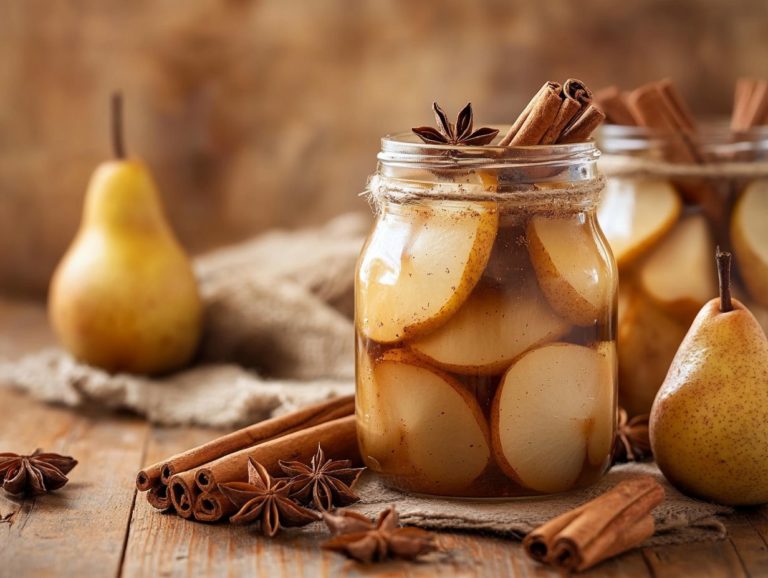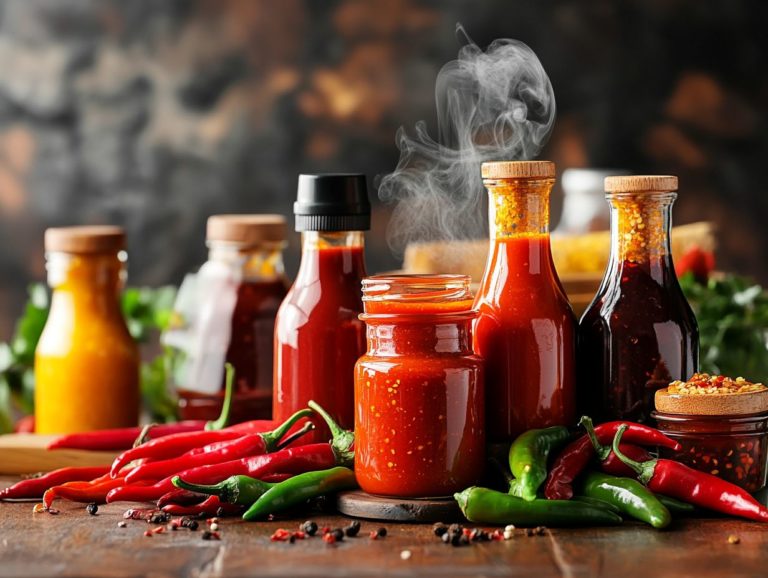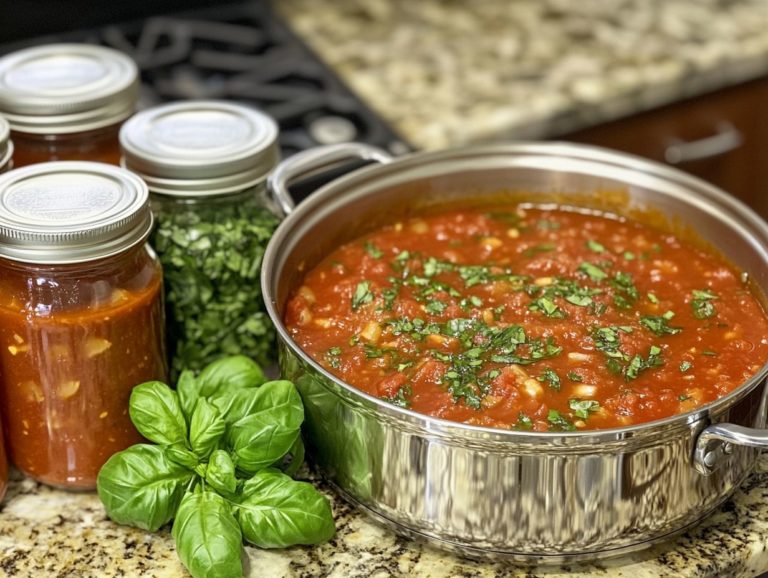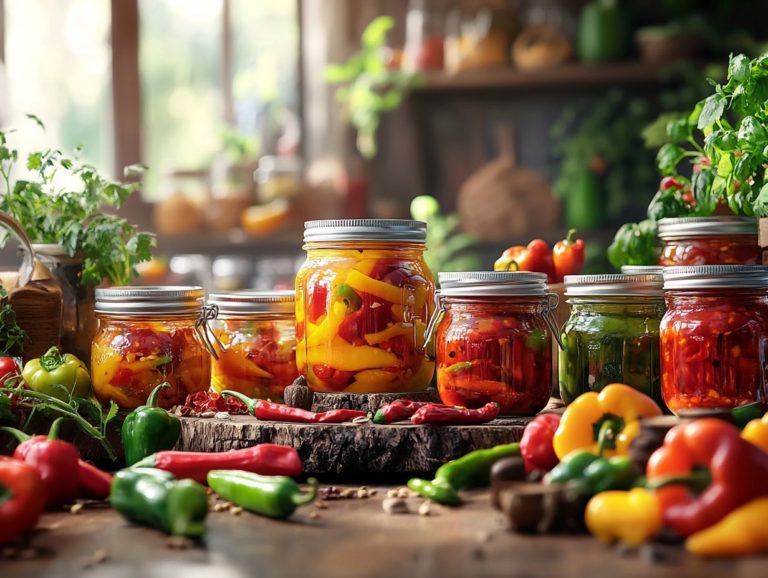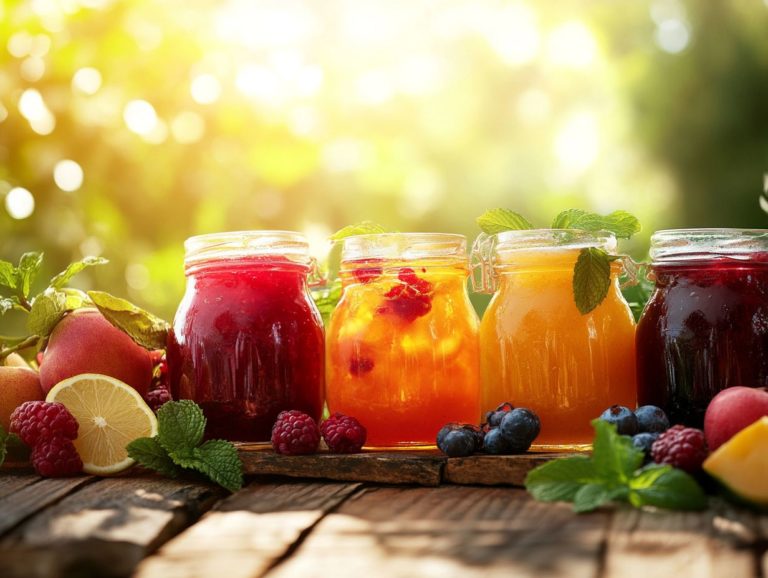Homemade Salsa Verde: A Canning Guide
Salsa Verde is a vibrant, tangy sauce that can elevate any dish. Making it at home lets you customize flavors and control the ingredients.
This guide will explore what Salsa Verde is and its origins. You will discover its delicious benefits, the ingredients needed, and a step-by-step process for canning your own batch.
You will also find tips for enhancing flavors and creative ways to serve this delightful sauce. Get ready to dive into the amazing world of homemade Salsa Verde!
Contents
- Key Takeaways:
- What is Salsa Verde?
- Benefits of Making Homemade Salsa Verde
- Ingredients and Equipment Needed
- How to Can Salsa Verde: A Step-by-Step Guide
- Tips and Tricks for Perfect Homemade Salsa Verde
- Using and Serving Homemade Salsa Verde
- Frequently Asked Questions
- What ingredients are needed for homemade salsa verde?
- Do I need any special equipment to can salsa verde?
- How do I prepare the canning jars and lids for salsa verde?
- What is the process for canning homemade salsa verde?
- How long will homemade salsa verde last when properly canned?
- Can I adjust the recipe to make different levels of spiciness?
Key Takeaways:
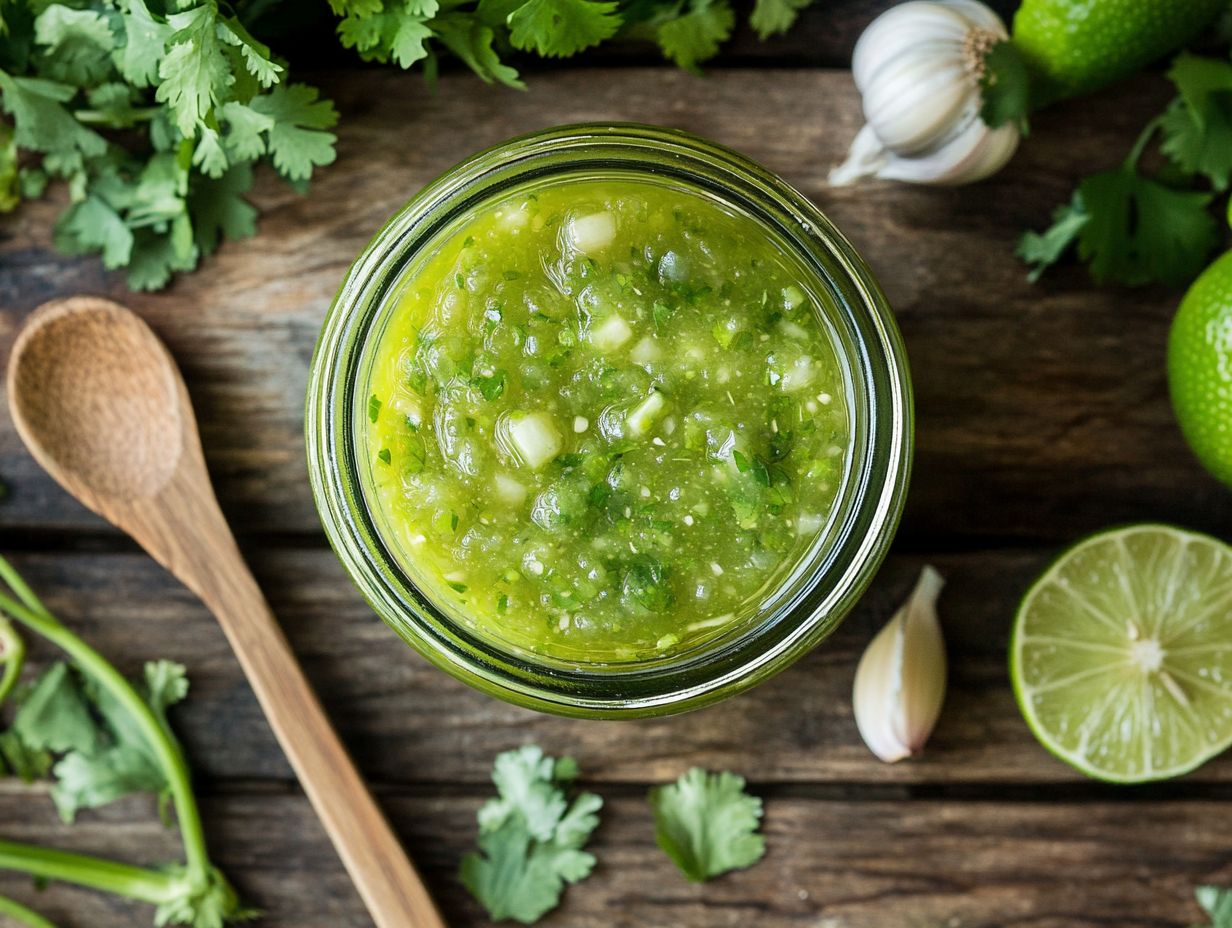
- Making homemade salsa verde offers both health and taste benefits. You can customize it to your preferences.
- Canning salsa verde is simple. With the right ingredients and equipment, you can easily store it for future use.
- Salsa verde is a versatile condiment. It can enhance a variety of dishes, from tacos to salads.
What is Salsa Verde?
Salsa Verde is a vibrant green sauce from Mexico. It is made from tomatillos, small green fruits with a tart flavor.
This tangy sauce is a staple in Mexican cuisine. It enhances dishes like tacos and enchiladas, adding a fresh, zesty touch.
Definition and Origin
Salsa verde, or ‘green sauce,’ is an iconic condiment from Mexico. It is primarily made from tomatillos, which deliver a unique flavor when roasted.
This lively sauce has deep roots in Mexican cuisine. It showcases fresh ingredients and reflects Mexico’s rich cultural heritage.
Originating in the Mesoamerican region, blending herbs and fruits into sauces has been practiced for centuries. Tomatillos are especially popular due to their unique acidity.
Roasted tomatillo salsa has made its way into kitchens worldwide. It evolves with culinary trends while keeping its authentic charm.
Benefits of Making Homemade Salsa Verde
Creating homemade salsa verde offers unmatched flavor and freshness. You can control the ingredients for healthier choices.
By using fresh tomatillos, zesty lime juice, aromatic garlic, and fragrant cilantro, you can craft a delightful dip. This allows you to take charge of what goes into your meals.
Health and Taste Advantages
The health and flavor benefits of homemade salsa verde are exceptional. Fresh ingredients like tomatillos, jalape o peppers, and cilantro enhance your dishes and provide nutritional rewards.
Tomatillos are rich in vitamin C and potassium, supporting heart health and boosting your immune function. Their tart flavor adds a zing. Jalape o peppers give heat and are rich in capsaicin, known for boosting metabolism and having anti-inflammatory effects.
Cilantro provides a fresh touch and essential oils that help detoxify the body. Together, these ingredients create a delicious blend that encourages a healthier lifestyle.
Ingredients and Equipment Needed
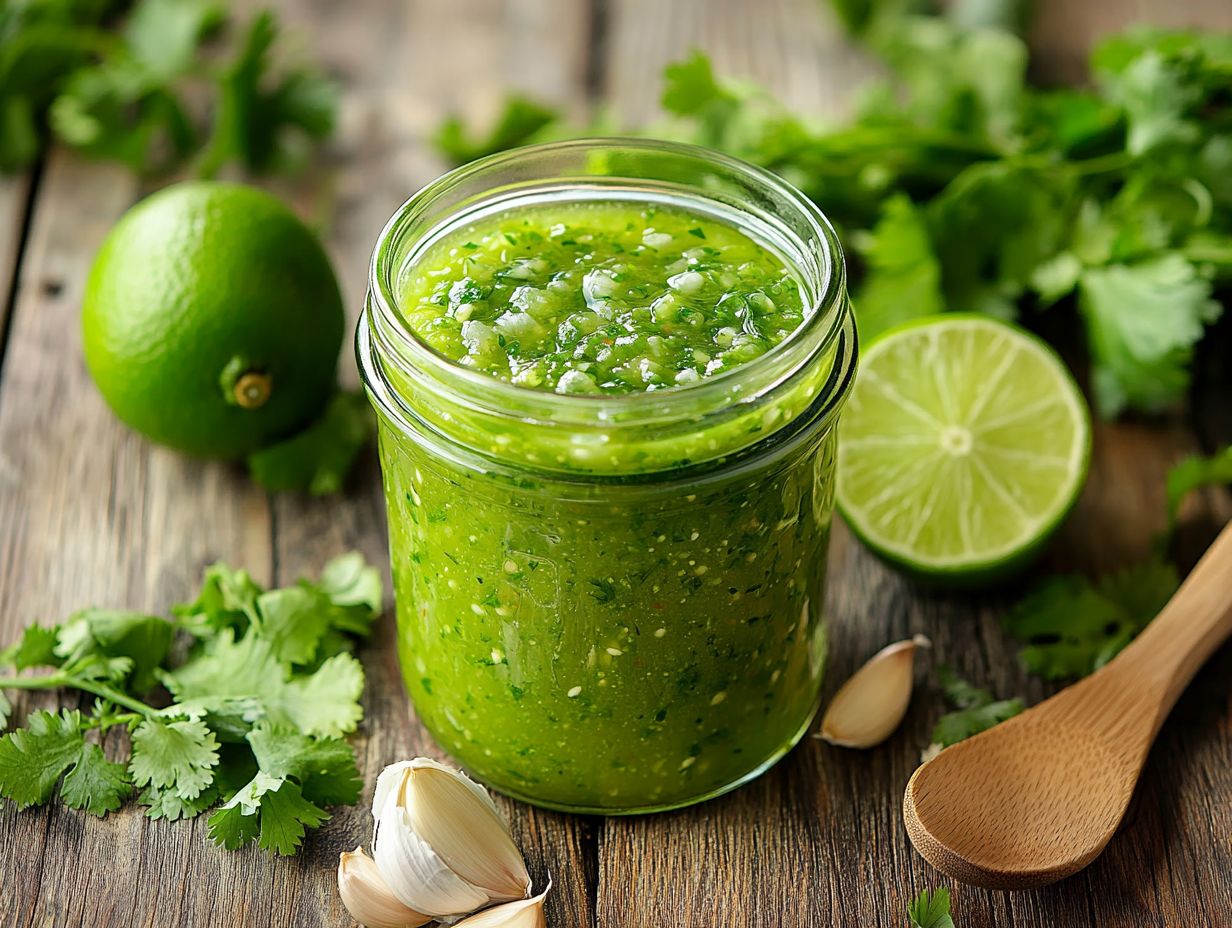
To create the ultimate tomatillo salsa recipe, gather a selection of fresh ingredients and essential kitchen tools, including canning equipment like jars and a water bath canner.
For a zesty salsa verde that packs a punch, make sure you have tomatillos, jalape o peppers, fresh lime juice, garlic cloves, kosher salt, and ground cumin on hand.
With these components, you ll craft a flavorful dip that can elevate any meal.
List of Necessary Items
To ensure a flawless salsa verde-making experience, start by gathering essential kitchen supplies: canning jars, a water bath canner, and a large saucepan for cooking your salsa.
High-quality canning jars with airtight seals are critical for maintaining the integrity of your salsa and preventing spoilage. The water bath canner plays a vital role in keeping the processing temperature consistent and safe.
A sturdy large saucepan ensures that your ingredients cook evenly, allowing the tomatoes, tomatillos, and herbs to release their flavors.
Investing in quality kitchen equipment streamlines your salsa-making process and elevates the overall taste and safety of your preserved goods.
How to Can Salsa Verde: A Step-by-Step Guide
Canning roasted tomatillo salsa verde is a careful process that guarantees both flavor and safety in preserving this delectable dip.
By following the cooking instructions with precision, you ll prepare the salsa using fresh ingredients, then process it in a canner to create vacuum-sealed jars. These jars can last for months, making your homemade condiment a perfect companion for any occasion.
Preparing and Cooking the Salsa
Preparing and cooking your salsa verde can be a delightful experience, especially with roasted vegetables like tomatillos and jalape os. Whether you use a food processor or a crockpot, adjusting the seasoning is crucial for achieving a perfect balance in your salsa.
- Begin by preheating your oven to 400 degrees Fahrenheit.
- Arrange the tomatillos and jalape os on a baking sheet, allowing them to roast until their skins are slightly charred, enhancing their natural sweetness and imparting a smoky character to your salsa.
- Once roasted, combine the vegetables in a food processor with fresh cilantro, lime juice, and garlic for a harmonious blend of flavors.
- Remember to taste as you go; adding salt gradually can elevate the dish. If your salsa lacks brightness, a splash more lime juice can work wonders.
Canning and Storing the Salsa
Now that your salsa is ready, it’s time to can and store it for later enjoyment! Heat your salsa in a large saucepan before pouring it into sterilized canning jars. Use a jar lifter for safe handling, and follow the canning process carefully to achieve a perfect vacuum seal.
This method eliminates harmful bacteria and maximizes the freshness of the ingredients, allowing the unique flavors to meld. After filling the jars, leave about half an inch of headspace (the space between the food and the lid) to accommodate expansion during sealing.
Once the jars are filled, wipe the rims clean to ensure a good seal before placing the lids on top. Correct sealing techniques, like adjusting the lids and monitoring processing times, are essential for creating that perfect vacuum seal vital for long-term storage.
When done right, your delicious salsa can last up to a year when stored in a cool, dark place, maintaining its delightful taste and nutritional value. Enjoy your newly canned salsa on a dish or share your creations!
Tips and Tricks for Perfect Homemade Salsa Verde
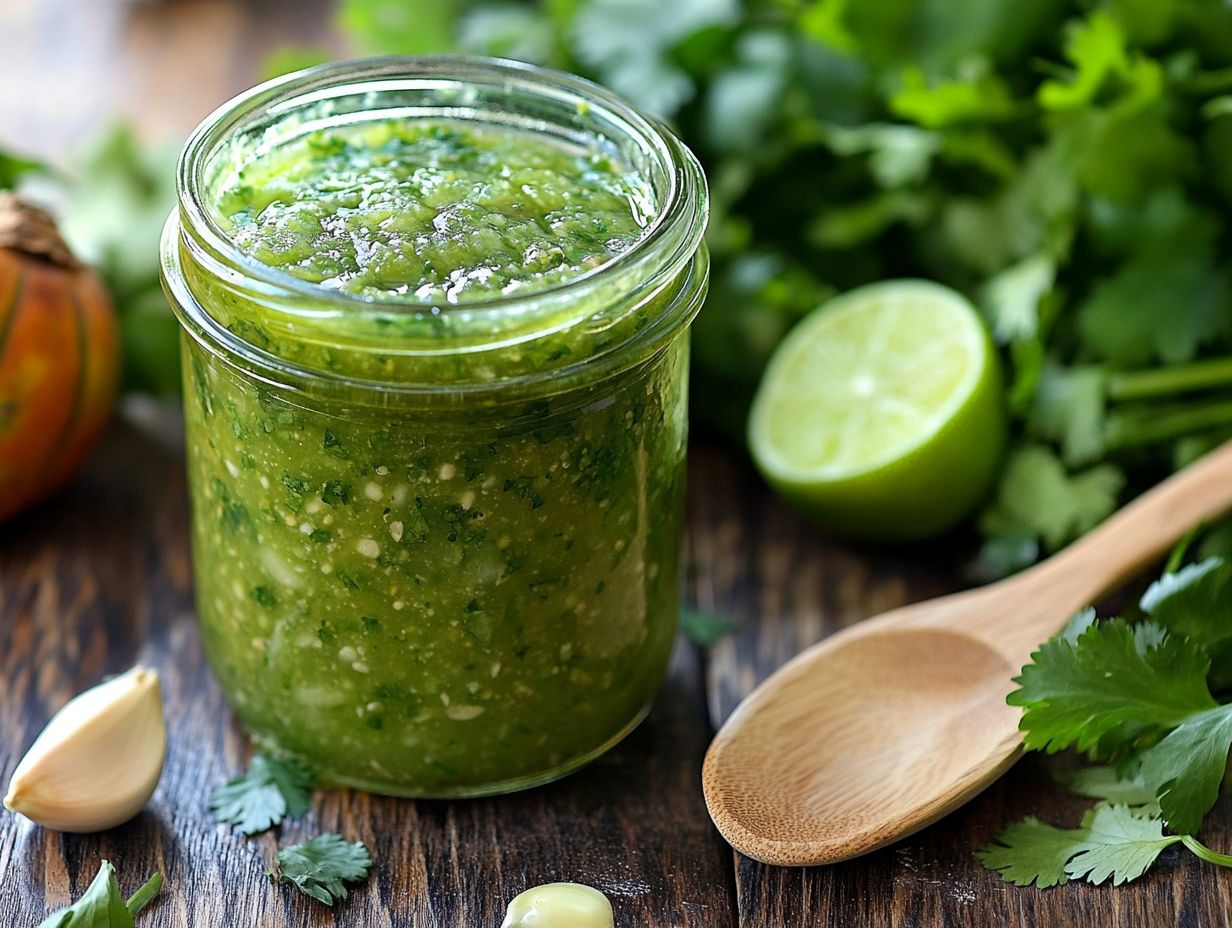
To craft the ideal homemade salsa verde, think about incorporating a range of flavor enhancers. Don t shy away from experimenting with recipe variations that highlight staple ingredients such as fresh lime juice, garlic, and cilantro.
These tips will transform your salsa into an unforgettable hit at any gathering, ensuring it becomes a memorable condiment.
Flavor Enhancers and Variations
Flavor enhancers like smoked paprika, lime zest, or a splash of vinegar can truly elevate your salsa verde, bringing depth and uniqueness to its profile. With various recipe variations some featuring roasted garlic or even fruit adjusting your seasoning is vital for achieving a well-balanced and vibrant taste.
By experimenting with ingredients such as chipotle pepper or fresh herbs, you can craft a dynamic flavor palette that delights the palate. If you’re in the mood to amplify sweetness, consider adding a touch of mango or pineapple for a delightful twist. A hint of cumin might introduce an earthy undertone.
Remember, mastering these variations isn’t just about the ingredients; it s also about achieving a careful balance of seasonings. Tasting as you go ensures your dish resonates with complexity and satisfaction, allowing both novice cooks and seasoned chefs to impress at the dinner table.
Using and Serving Homemade Salsa Verde
Homemade salsa verde offers exceptional versatility. It elevates a range of dishes from tacos and fajitas to serving as a zesty appetizer alongside tortilla chips. You can also serve it with grilled meats, such as salsa verde chicken.
With this vibrant sauce in your cooking options, you ll discover endless possibilities for enhancing your meals.
Recipe Ideas and Pairings
Salsa verde can elevate ordinary dishes into extraordinary culinary experiences. Picture it topping grilled chicken or shining in a delightful chicken and white bean chili. Whether you’re whipping up tacos, fajitas, or exploring unique combinations, these recipes showcase the versatility and vibrant flavor that homemade salsa verde can bring to your table.
Imagine drizzling it over roasted vegetables for a zesty twist that adds freshness with herbs and acidity. For a delightful appetizer, enjoy salsa verde with crispy tortilla chips or blend it into a creamy avocado dip for that extra layer of flavor. It can even be swirled into soups for a refreshing lift, effortlessly bridging various cuisines.
The fusion potential is endless. When you incorporate it into pasta dishes or grain bowls, the vibrant verde invigorates each bite, transforming a simple meal into a flavorful experience that keeps everyone coming back for more.
Frequently Asked Questions
What ingredients are needed for homemade salsa verde?
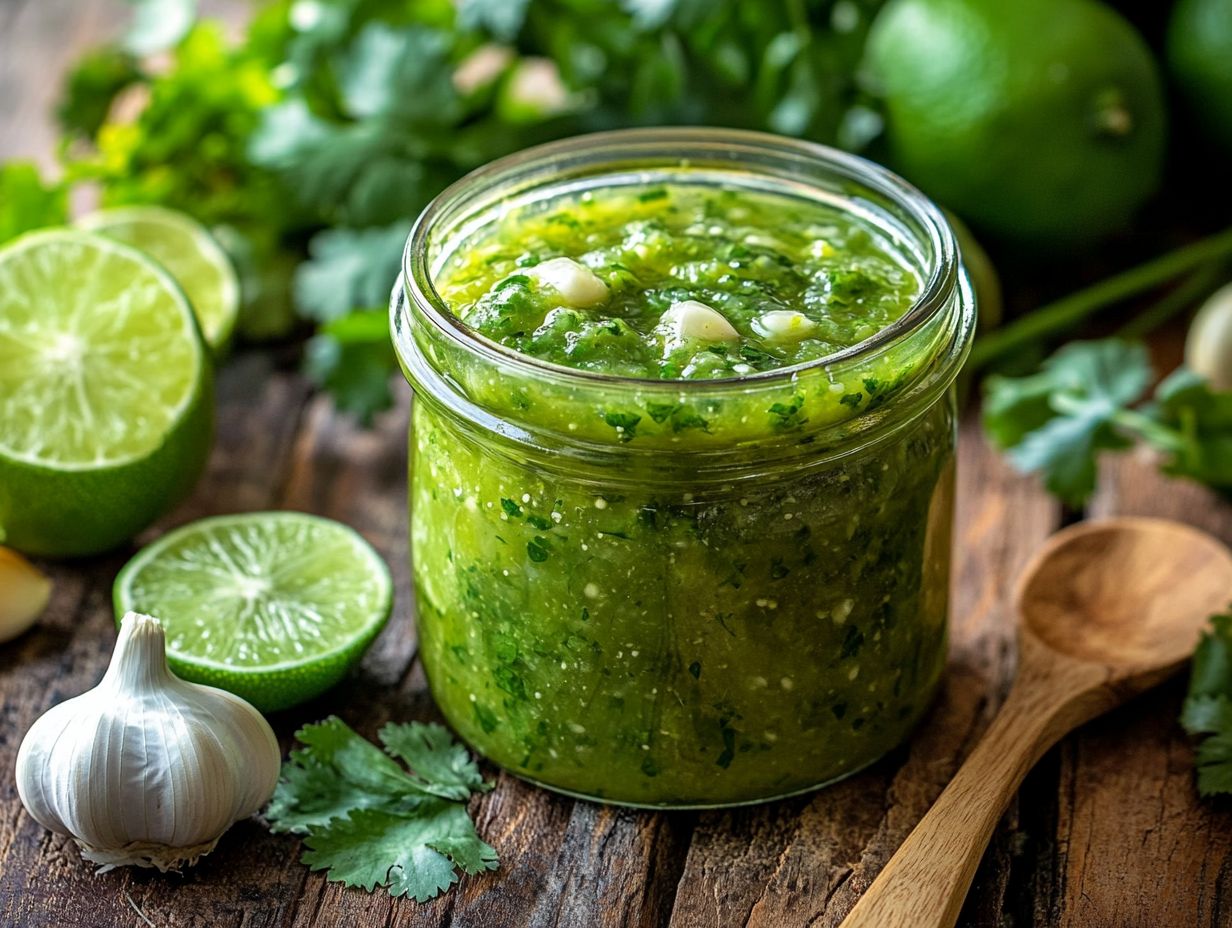
To make homemade salsa verde, you will need to gather tomatillos, onions, garlic, jalapenos, cilantro, lime juice, salt, and water. For enhanced flavor, consider using ground cumin and kosher salt as seasonings.
Do I need any special equipment to can salsa verde?
Yes, you will need canning jars, lids, and bands. A large pot for boiling water and a canning rack to keep the jars off the bottom of the pot are also essential. A water bath canner a large pot designed for canning is recommended for the process.
How do I prepare the canning jars and lids for salsa verde?
Before filling the jars with salsa verde, sterilize the jars and lids by boiling them in water for 10 minutes. Keep them warm until you’re ready to use them. Using a jar lifter can help safely remove the jars.
What is the process for canning homemade salsa verde?
After preparing the jars and lids, fill them with salsa verde, leaving 1/2 inch of headspace. Wipe the rims, place the lids on top, screw on the bands, and then process the jars in a boiling water bath for 15 minutes. Remember to remove husks from tomatillos!
How long will homemade salsa verde last when properly canned?
If stored in a cool, dark place, canned salsa verde can last up to a year. Once opened, consume it within a week and store it in the refrigerator. For the best quality, consider using vacuum-sealed jars for longer storage.
Can I adjust the recipe to make different levels of spiciness?
Absolutely! You can spice up your salsa verde by adjusting the amount of jalapenos used. Experiment with other peppers or spices to customize the flavor to your liking.


